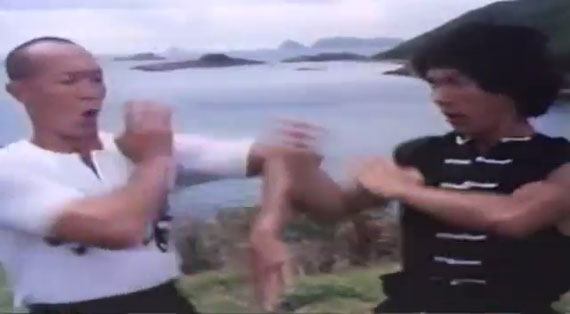
Bong Sau Addiction
September 30, 2012
We are addicted to our thoughts. We cannot change anything if we cannot change our thinking.
Santosh Kalwar
There are at least two types of dangerous addictions rampant in Wing Chun training; one is doing Chi Sau to the exclusion of all other training and one is having Bong Sau be your first defense.
Bong Sau is the trademark Wing Chun move. But doing it at the wrong time can get you killed.

Real fights, in which people get hurt or even killed, happen in the blink of an eye. Some times, neither the fighters nor the spectators see what happens, then its over.
In fights between unskilled opponents, you often see everything because most of the fight is preliminaries. There is a lot of talk, posturing, and gradual escalation. Then its scrambling all over the map as they flail around, heads down, eyes closed.
Even after the first attack is thrown, often some sort of shove or jab, the participants avoid actually fighting. They stay out of range and circle one another and do more talking. There is a lot of reaching for one another from too far away, with brief bursts of grappling and then breaking apart.
This is the amateur’s version of fighters finding their range. But it is also a lack of nerve and caution. They are trying to find a right moment to attack that is “safe.”
A trained fighter knows that the longer the fight goes on, the more danger they are in, so they do not circle or delay. Once they decide they must fight rather than leave, they get within range and then attack.
Faced with an attack by a skilled opponent, many inexperienced Wing Chun fighters throw a Bong Sau to avoid getting hit. This is because their training has misled them.
Bong Sao seems important because it is the signature move of Wing Chun. Its in Siu Lum Tao, Dan Chi Sao, and its a basic repeated move in Chi Sao.
We do it over and over.
We learn, especially in the early stages of training, that Bong Sao can save our ass. Its a quick, very natural response to an attack to the head. We learn to do Bong Sao as an “Oh, Shit!” defense.
Don’t get me wrong – Bong Sao is an important secondary movement. It’s a useful linking movement for drills, because you can usefully use it to reset and do a drill again. It’s important to Chi Sao because it is a Tan Sao upside down, so it can be used to simulate launching an attack then defending against an attack, back and forth, over and over. Its useful for changing .
But it’s not an intelligent first action. In Wing Chun, your first action must always contain an attack. There is no way to perform a Bong Sau and simultaneously attack! Wing Chun is a system based on simultaneous attack and defense. But the attack is more important than the defense. In Wing Chun, the attack is the defense.
Inexperienced Wing Chun fighters, like inexperienced fighters of any type, try to defend and delay – its natural. They hope they will somehow find a safe position from which to attack, if given enough time.
Experienced fighters defend by attacking. They create their opportunity rather than hoping it will appear through luck.
If I throw Bong Sao after Bong Sao in response to your attacks, I am only prolonging the moment when I must attack. If you never attack, your opponent can continue to press their offense.
This is what the Lap Sao drill teaches. Bong, then HIT. Bong, hit. Bong, hit. In the Gary Lam lineage, we do Wrong Bong drills. The Bong is always followed by an aggressive recovery. Never bong without following it immediately with an attack.
Also, the Bong is structurally unsound. All your opponent has to do is cover (get on top) and put some weight on that shape – it will collapse and they will hit or grab over the top of this fallen position.
Remember this: your first action should be an attack , preferably attacking the head of your opponent. Your job is to stop the fight. Wing Chun stops fights through knockout. Knockouts only result from attacks to the head. So you must attack the head. Its that simple.
For more on this subject, here is a good video by James Sinclair, a senior student of Ip Chun’s teaching in the UK.